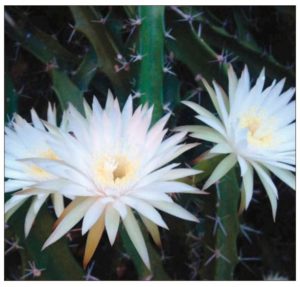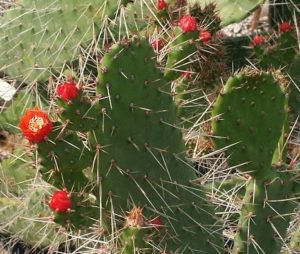While many folks associate cactus with the sand and heat of a desert in the western part of the United States, South Florida and the Florida Keys are home to six species of native cacti. In this week’s edition of Nature’s Corner, we will introduce you to two native Florida Keys cacti: the barbed-wire cactus and the Florida semaphore cactus.

The barbed-wire cactus is one that you can see just by driving into John Pennekamp Coral Reef State Park. A large barbed-wire cactus is located right in front of the ranger station before you are greeted by the attendant. The plant is hard to miss, and when you look at the large spines coming from the cactus, it is certainly easy to see how they received their common name. However, these large spines don’t seem to deter animals from using the cactus as cover. You can often find reptiles and other small animals crawling around the perilous spines. The barbed-wire cactus grows in several habitat types, and arches as it gets bigger. It produces flowers that bloom at night when its pollinator, the hummingbird moth, is active. The berry that is produced is bright red in color. The barbed-wire cactus can grow to be more than 20 feet tall.
They are also known as night-blooming cereus and are related to the Dragon Fruit cactus. The fruit of all these species of cacti are edible but some like the Dragon Fruit are better tasting than others. Young stems of the barbed-wire cactus can be eaten as a vegetable either cooked or raw, while the fruits are edible and sweet. It is sometimes cultivated as an ornamental.
Another cactus that grows here is the Florida semaphore cactus. It is an endemic species, which means that it only grows in the Florida Keys and is currently only found from Sands Key to Big Pine Key. This cactus grows to be around 6 feet tall and is extremely rare. It is listed as endangered by the state of Florida and the federal government. Efforts to protect the semaphore cactus have been going on for more than 20 years. Saltwater intrusion, hurricanes, vandalism and the invasive Cactoblastis moth are all threats to its survival. The flower is orange and red, but without pollination, fruits have not been observed for many years.

The Florida Semaphore Cactus is in the family of Pricklypear cacti. The flowers, which have a scent reminiscent of rotting meat, have fleshy outer tepals and red-colored inner tepals that reach 1 inch in length. Flowering occurs year-round, with a peak season in December through April. There is no fruit as the plants in existence are solely male and pollination is impossible. This cactus is colonial, forming colonies of “trunked” plants and several “pups”. This species’ common name refers to its resemblance to railway semaphore signals.
Because of our location and climate, the Florida Keys is a unique place to observe nature; many of our native plants and animals are only found here. This distinctiveness attracts wildlife lovers from all over the world to have the chance at seeing the interesting species that live here. Whether you’re from out of town or a local, there’s always something new to discover in the “Real Florida.” Visit one of your nearby state parks or trails; there are over 170 to choose from. Plan your adventure at floridastateparks.org.
Lindsey Crews is a park ranger at John Pennekamp Coral Reef State Park.
